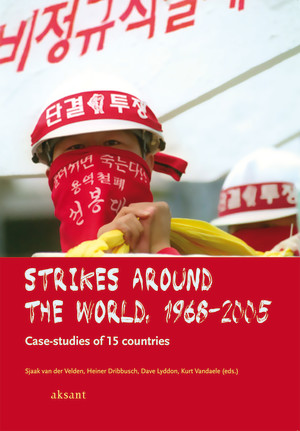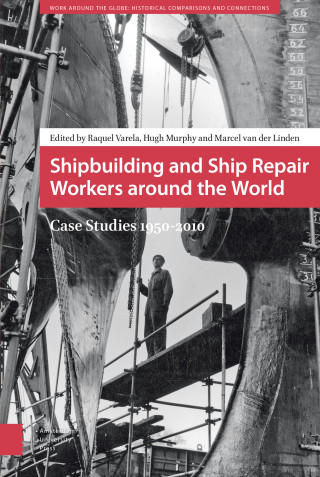
Strikes around the world
Case-studies of 15 countries
Are strikes going out of fashion or are they an inevitable feature of working life? This is a longstanding debate. The much-proclaimed ‘withering away of the strike’ in the 1950s was quickly overturned by the ‘resurgence of class conflict’ in the late 1960s and 1970s. The period since then has been characterized as one of ‘labor quiescence’. Commentators again predict the strike’s demise, at least in the former heartlands of capitalism.
Patterns of employment are constantly changing and strike activity reflects this. The secular decline of manufacturing in mature industrialized economies is of major importance here (though the global relocation of manufacturing may lead to some ‘relocation’ of strikes). Simultaneously we see the growth of disputes in the service sector (the ‘tertiarization’ of strikes). This is evident particularly in public services, including health care, social care and education, and is accompanied by a ‘feminization’ of strikes, given the prevalence of women working there.
This unique study draws on the experience of fifteen countries around the world – South Africa, Argentina, Canada, Mexico, United States, Korea, Australia, New Zealand, Belgium, Denmark, France, Germany, the Netherlands, Sweden and the United Kingdom. Covering the high and low points of strike activity over the period 1968–2005, the study shows continuing evidence of the durability, adaptability and necessity of the strike.
Patterns of employment are constantly changing and strike activity reflects this. The secular decline of manufacturing in mature industrialized economies is of major importance here (though the global relocation of manufacturing may lead to some ‘relocation’ of strikes). Simultaneously we see the growth of disputes in the service sector (the ‘tertiarization’ of strikes). This is evident particularly in public services, including health care, social care and education, and is accompanied by a ‘feminization’ of strikes, given the prevalence of women working there.
This unique study draws on the experience of fifteen countries around the world – South Africa, Argentina, Canada, Mexico, United States, Korea, Australia, New Zealand, Belgium, Denmark, France, Germany, the Netherlands, Sweden and the United Kingdom. Covering the high and low points of strike activity over the period 1968–2005, the study shows continuing evidence of the durability, adaptability and necessity of the strike.
- Title
- Strikes around the world
- Subtitle
- Case-studies of 15 countries
- Editors
- Sjaak van der Velden
- Heiner Dribbusch
- Kurt VanDaele
- Price
- € 54,99
- ISBN
- 9789048521128
- Format
- eBook PDF (Adobe DRM)
- Number of pages
- 352
- Language
- English
- Publication date
- 10 - 05 - 2008
- Dimensions
- 17 x 23.8 cm
- Discipline
- Social and Political Sciences
strikes around the world, 1968–2005 - 2
Contents - 6
General glossary - 10
Editors’ foreword - 11
Introduction - 13
Strike statistics and the problems of international comparison - 25
A racially divided class Strikes in South Africa, 1973–2004 - 41
A century of general strikes Strikes in Argentina - 62
Public sector militancy, feminization,and employer aggression Trends in strikes, lockouts, and wildcats in Canada from 1960 to 2004 - 87
Strikes in a state corporatist system Mexico - 115
Approaching extinction? The decline of strikes in the United States, 1960–2005 - 134
Militant unionism in Korea - 156
Strikes and lockouts in the Antipodes Neo-liberal convergence in Australia and New Zealand - 174
From the seventies strike wave to the firstcyber-strike in the twenty-first century Strike activity and labour unrest in Belgium - 197
The persistence of labour unrest Strikes in Denmark, 1969–2005 - 223
Strikes in France Strong social eruptions and a weak tradition of collective bargaining - 244
Industrial action in a low-strike country Strikes in Germany 1968–2005 - 268
Strikes behind the dykes Netherlands, 1965–2005 - 299
From blue-collar wildcats in the 1970s to public sector resistance at the turn of a new millennium Strikes in Sweden 1970–2005 - 322
From strike wave to strike drought The United Kingdom, 1968–2005 - 340
Comprehending divergence in strike activity Employers’ offensives, government interventions and union responses - 367
Contributors - 383
Related titles

The Painted Triptychs of Fifteenth-Century Germany
Lynn F. Jacobs

Secularism and Its Ambiguities
Carlo Ginzburg

Shipbuilding and Ship Repair Workers around the World
Raquel Varela, Hugh Murphy, Marcel van der Linden (eds)

The Early 20th Century Resurgence of the Tibetan Buddhist World
Ishihama Yumiko, Alex McKay (eds)
